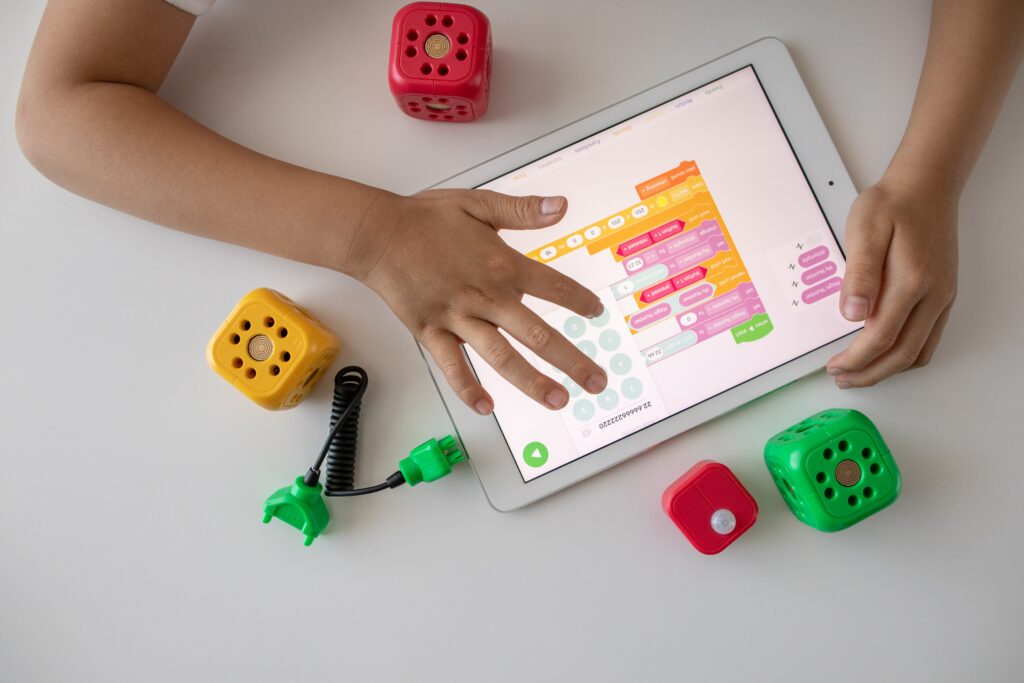Teaching Coding in Schools
The 21st century is a technology-rich world, our everyday lives are filled with different variations of technology and school classrooms are no exception. In a world that depends so heavily on computers, doesn’t it make sense to teach our children how to properly use them? We believe so, which is why we feel basic coding should be incorporated into K-5 classrooms! So much of education has become part of the digital world, our students are regularly working on and producing assignments on computers which is why classrooms should embrace teaching children to create through coding. After all, education is dedicated to learning, doesn’t it make sense to learn computer skills in that education?
Coding can teach kids skills that relate to our education curriculum beyond just computer science. Perhaps the most important skills children develop through learning to code are problem solving and critical thinking. Critical thinking and problem solving are some of the most important skills we use in our lives and the earlier children learn them, the better off they will be. Learning to code places children in control of the computer, allowing them to develop skills and confidence with the technology that they may not otherwise have. It teaches them basic computer skills that will help them greatly in their future careers as well as empower them to take on challenges in the future.

But Why Elementary School?
It may seem over the top to teach coding in elementary school, perhaps coding sounds like a topic better suited for high school. However, elementary-aged students are at a special point in their lives where they are constantly absorbing and learning new information. It’s the perfect time to introduce the concept and skills. Plus, children don’t need solid reading skills to start learning basic coding. You may think reading abilities are a requirement for coding but plenty of programs exist for children that don’t require solid reading skills. This means children can start learning as early as possible.
Research even indicates that introducing coding should be done as soon as possible since at young ages there is a significantly smaller gender gap in participation. At a young age participation in coding is split about evenly between genders however, as students get older a gap forms and participation leans heavily towards males.
However, the gender gap isn’t the only reason to introduce coding early. Coding teaches collaboration, teamwork, and brings student ideas alive. It is empowering for students to learn and helps them develop a positive relationship with technology. Last, but certainly not least, it’s a topic that sparks interest in children. They want to learn to code and are often highly engaged in such activities and learning.
Check Out this Poem Art Made Using Code Studio
So, What are the Benefits?
Despite everything we’ve said so far, you still might not be convinced. That’s completely understandable so we created a straightforward list of some benefits of elementary students learning code. Check it out below!
- Teaches critical thinking and logical thinking
- Teaches problem solving skills and cause/effect relationships
- Teaches useful computer skills that will be helpful in the future
- Builds positive relationships with technology
- Empowers children!
- Develops confidence and positive self-beliefs
- Provides children with a creative outlet to express themselves
- Enhances math abilities
What about the Drawbacks?
Although there are plenty of benefits, some people still see coding in schools in a negative light. Listed below are some of their reasons:
- Coding is viewed as an unnecessary skill.
- Kids should be kids instead of sitting hunched in front of a computer
- The need for programmers and coders is declining. “This is mostly due to an increase in coding software that removes the necessity for coders.” (Betts, LoveToKnow)
- The types of coding activities tend to “misrepresent much of the work IT professionals do.” (The Conversation) To work in IT, computer science and software engineering are essential skills to possess, but does the coding taught in elementary schools properly reflect these skills? Most often, no. There is a focus on accessibility and engagement, causing a loss in perspective in the IT field for young students.
The following article provides an interesting perspective on teaching coding in schools.
Three Challenges of Teaching Code
Clearly, there are many benefits to teaching children code in elementary school. However, there are definitely challenges that educators experience when attempting to teach code. In a sense, teaching code is teaching a second language, which can be incredibly difficult. Here are the biggest three challenges:
- Engaging your students with coding
- The big screen time debate
- How to teach code if you don’t know how to code?
A possible solution to engagement is to add elements from gamified learning to the coding class. Another strategy to increase engagement is to try the flipped learning model, which allows students to experience lesson delivery outside of class time and leaves class time open for hands-on learning.
For the screen time debate, utilizing the students’ screen time as an educational tool allows educators to use screen time in their favour. An example would be to allow students to use their phones or tablets as note-taking devices including sketchnoting. Educators teaching coding need to always consider how to include screens in the optimal learning environment. Some possible examples are using platforms such as Kahoot, Typeform, Annoto, Pear Deck, and CoderZ. They allow students to be engaged and learn while using technology without any fears of negative screen time. A big part of the screen time debate relates to the frequency of screen use. So, creating specific opportunities for technology creates a positive technology experience in a set amount of time.
For educators with no coding abilities or knowledge, there are many barriers for them including, lack of time, new educational tools, advanced pedagogical methodologies, and expansive innovations in deliverable content. Educators with lacking coding skills need only turn to technological tools that benefit both students and educators. Some platforms, such as ISTE, provide lesson plans and step-by-step instructions for educators. CoderZ has three different curriculums to offer teachers: Cyber Robotics 101, Cyber Robotics 102, and Coding Robots. Educators need only search for these platforms and share their resources with the education community.
A List of Kid-Friendly Coding Websites:
Scratch (age 8+)
Code studio (4+)
Kodable (doesn’t require reading skills)
Bee-Bot app (teaches directional language alongside programming)
Scratch Jr. (block coding for 5-7)
CodeCombat (collaborative)

Leave a Reply
You must be logged in to post a comment.